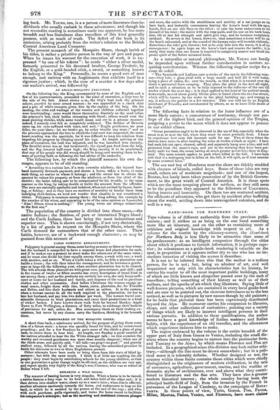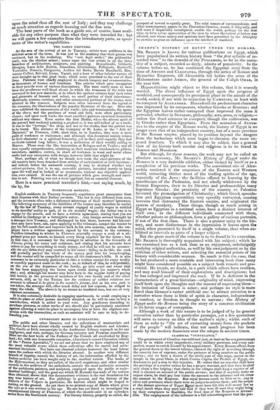HAND-BOOK FOR NORTHERN ITALY.
Tuts volume is of different authorship from the previous publications; and it strikes us as being on the one hand something more like an itinerary, and on the other as containing more of criticism and original knowledge with respect to art. As a volume for the tourist by the chimney-corner, the Hand-book for Northern Italy is less likely to be attractive than some of its predecessors : as an intelligent companion through the cities about which it professes to furnish information, it is perhaps superior; its minuteness as a guide-book rendering it valuable on the spot, in proportion as it appears rather dry, to one who has no immediate intention of visiting the scenes it describes. It is not to be inferred from this that the author is a tedious person, for he is not ; but, being an admirer of art, and well acquainted not only with its characteristics but its history, be. carries his reader to all the most important public buildings, many of which are little known and altogether passed over by the mob of travellers ; telling something of their history as well as of their authors, and the epochs of art which they illustrate. Saying little of well-known pictures, which are contained in every local guide-book and are sure to be pointed out, the cicerone introduces us to the less noticed, as well as to pictures by new names though by old painters ; for he holds that pictorial fame has been capriciously distributed beyond the Alps. He moreover carries his companion to libraries, shops, and other collections of curiosities ; pointing out a variety, of things which are likely to interest intelligent persons in their various pursuits. In addition to these qualilictitions, the author seems to have a good knowledge of Italian manners and Italian habits, with the experience of an old traveller, and the allowances which experience induces him to make. The region embraced by the volume is the entire breadth of the upper part of Italy from Genoa to Venice, including the small districts where the country begins to narrow into the peninsular form, and Tuscany to the Arno; by which means Florence and Pisa are included. In a geographical sense this division may look rather arbitmry,—although the line must be drawn somewhere ; but in a poll.. tical sense it is tolerably definite. Whether designed or not, the country within these limits contains those cities which were chiefly distinguished as the originators of modern civilization, in the arts of commerce, agriculture, government, marine, and the warlike or domestic styles of architecture, over and above what they contributed to literature and the fine arts. They have also a greater modern historical interest; the whole country having been the principal battle-field of Italy, from the invasion by the French in pursuance of the League of Cambray, to the campaigns of BONA.. PARTE. III these points of view, Turin Genoa, Pisa, Parma, Milan, Mantua, Padua, Venice, and Florence, have mace ado*
upon the mind than all the rest of Italy ; and they may challenge as much attention as regards learning and the fine arts.
The best parts of the book as a guide are, of course, least available for any other purpose than what they were intended for; but we will quote a few examples from the introductory parts, as specimens of the writer's capabilities.
THE EARLY PAESTERS.
At the era of the revival of eat in Tuscany, artists were artificers in the e trictest sense of the term. It was not in the academy that their genius was nurtured, but in the workshop. The " arte degli orefici," the goldsmiths' Craft, was the chiefest school : hence came the best artists in all the three branches of architecture, sculpture, and painting. 13runelleschi, Ghiberti, ()soigne, Luca della Robbie, Massolino, Ghirlandajo, Pollajuolo, Botticelli, Verrochio, Francis, Finiguerra, Andrea del Sarto, Baccio Bandinelli, Benvennto Cellini, Salviati, Lione, Vasari, and a host of other inferior names, all were brought up in this good trade, which some practised to the end of their lives. Painters were chiefly employed in church imagery and ornamentation, es decorators of houses and furniture. The articles which gave occupation to their pencils were of various descriptions. The most costly seem to have been the ponderous well-lined chests in which the trousseau of the bride was conveyed to her new domicile, or in which the opulent citizens kept their robes and garments of brocade and velvet, no small portion of their inheritance. Bedsteads, screens, cornices, and other ornamental portions of the rooms, were adorned in like manner. Subjects were often borrowed from the legend or the romance, the illustrations of the popular literature of the age. Here also were exhibited the amusements of the world ; tilts and tournaments, the sports of the chase, and the pastimes of wood and field, were often particularly chosen; and upon such works the most excellent painters exercised themselves without any shame. Even under the first Medici, when the altered spirit of the pursuit had rendered painting a profession, it was still talked of as a trade. It was in the "bottega," the shop, and not in the studio, that the painter was to be found. The statutes of the Company of St. Luke, or the " Arti de' Dipintori," at Florence, 1386. show that, as in London, they were a mere guild of workmen or tradesmen ; and although this document mainly relates to their character as a spiritual fraternity, yet in their civil capacity they had no doubt existed long before ; it was a dedication of their worldly calling to Heaven. There were the like fraternities at Bologna and at Venice ; and all were equally comprehensive, admitting as their members trunkmakers, gliders, varnishers, sadcllers, enders, in short all workmen in wood and metal whose crafts had any connexion with design, however little that might be.
Most, perhaps all, of what we should now term the easel-pictures of the old masters have been detached from articles of ecclesiastical or civil furniture ; and indeed, before the sixteenth century, it may be doubted whether any cabinet-pictures, that is to say, moveable pictures, intended merely to hang upon the wall and be looked at as ornaments, without any objective application, ever existed. It was the use of pictures which gave strength and nutrition to art. Painting was not a mere applique, but an essential element.
Here is a more practical traveller's hint,—not saying much, by the by, for PLORENTINE HONESTY.
English residents in Tuscany frequently experience great annoyance from their disputes with their Italian servants. The law is very different from ours, and the servants often take a dishonest advantage of their masters' ignorance. The following summary of the liabilities of the master may therefore be useful. By the law of Tuscany, every servant engaged at yearly wages is entitled to six months' notice to quit, or to six months' wages: the better way is to engage by the month, and to have a written agreement, stating that you are entitled to discharge at a fortnight's notice. Any foreign servant brought by e stranger into Tuscany, and discharged by him there, however bad his conduct may have been, can, upon applying to the tribunals, compel the master to pay his full coach-fare and expenses back to his own country, unless the employer have a written agreement, signed by the servant, to the contrary. Families intending to winter in Florence generally engage a cook at a stipulated price per month, to furnish every thing required for the house: but, in this case, it is necessary for the stranger to advertise in the Gazzetta di Firenze, giving his name and residence, and stating that his servants have orders to pay for everything in ready money, and that he will not be accountable for any debts they may contract in his name : failing to do this, the cook will probably pocket the whole of the money paid him for housekeeping, and the master will be compelled to repay all the tradesmen's bills. It is also necessary to be extremely particular to take a written receipt for every weekly or monthly payment made to the cook ; as, in default of this, he will probably, on the eve of the departure of the family, go into court and swear that he has been suppplying the house upon credit during his master's whole stay; and, although his master may have been in the regular habit of paying him weekly in the presence of members of his own family and of the other servants, still, as by the Tuscan law the evidence of neither relations nor servants is allowed to be given in the master's favour, and as his own oath is not taken, the stranger will, after much delay and law expense, be obliged to repay the whole. The above is by no means an insolated case, but one of very common occurrence.
It is also extremely desirable in engaging apartments, to avoid employing a valet-de-place or other person similarly situated, as he will be sure to levy a contribution, which is added to your rent. Any gentleman intending to purchase pictures, or other works of art, should also be particularly cautioned against allowing a valet-de-place to accompany him or have the slightest connexion with the transaction, as such an assistant will be sure to help in defrauding you.
UNWROUGHT MINES IN LITERATURE.
The public and other libraries, and the collections of manuscripts and archives, have been almost wholly unused by English students and scholars. The Gaelic or Irish manuscripts in the Ambrosian Library reproach us for our negligence, and wait, perhaps' for German industry and Prussian munificence. Here are the best texts of the Fathers of the Church all overlooked by England; for, with one honourable exception, (Jacobson's recent Clarendon edition of the Patres Apostolici,") we are not aware that we have employed any of the most valuable stores which these collections offer for sacred and ecclesiastical literature. Nor have our classical scholars bestowed the least labour upon the codices with which the libraries abound. In another very different branch of inquiry, namely the history of art, the information afforded by the Italian archives has been sought only to the smallest extent. The books of the Riforrnazioni, as they are called, of the civil magistracy, and other similar records in the archives of the cathedrals, contain the most authentic accounts of the architects, painters, and sculptors, employed upon the public or ecclesiastical building's; and the good use which M. Eumohr has made of the notices thus obtained, shows that this documentary evidence is the real foundation for any true history of art. For philology in general, and the history of the dialects of the Volgare in particular, the harvest which might be reaped is rotting on the ground. As yet there is no printed copy of Dante which gives the text as it RSIS written in his age. No one has yet dared to investigate the constitutional history of Florence, of which the records exist in an unbroken series from the fourteenth century. For literary history, properly so called, the prospect of reward is equally great. The solid masses of correspondence, and other contemporary papers in the Florentine libraries, would, if diligently, and still more if impartially investigated, enable the world, perhaps for the first time, to form a true appreciation of the men by whom the revival of letters wee effected, and whose names and opinions have been permitted by the Almighty to exercise so great an influence upon the intellect of mankind.



























 Previous page
Previous page